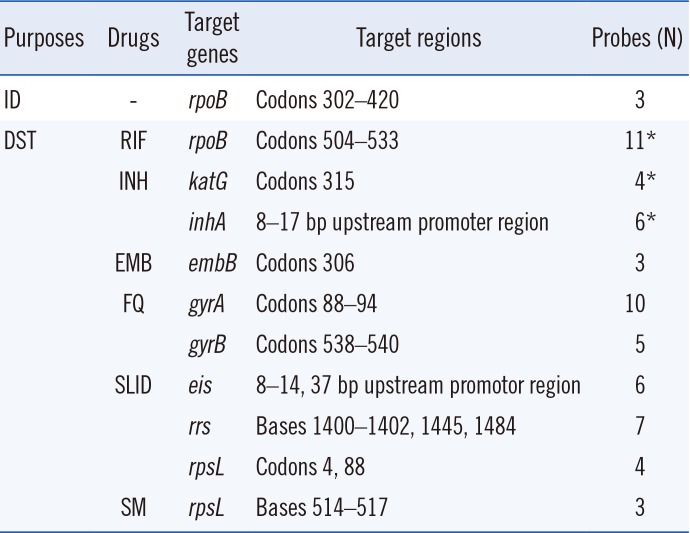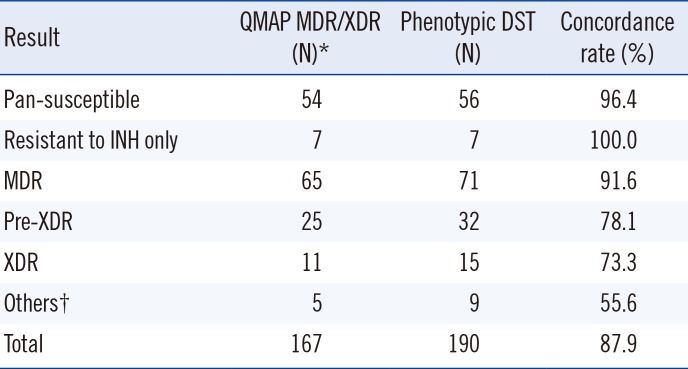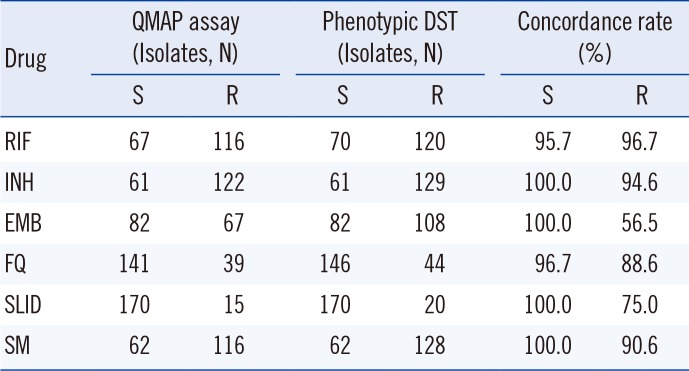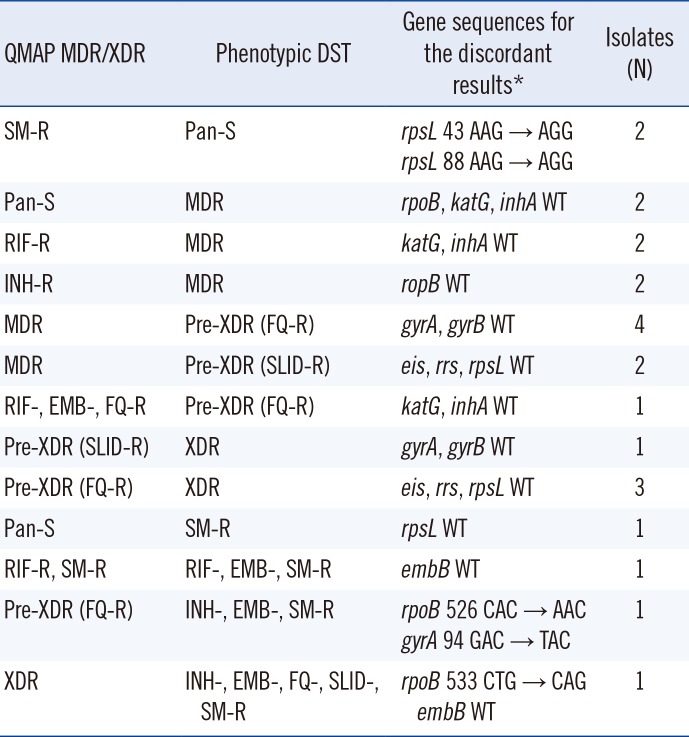4. Choi J, Yoo J, Kim KJ, Kim EG, Park KO, Kim H, et al. Rapid drug susceptibility test of
Mycobacterium tuberculosis using microscopic time-lapse imaging in an agarose matrix. Appl Microbiol Biotechnol. 2016; 100:2355–2365. PMID:
26754815.
5. Pang Y, Dong H, Tan Y, Deng Y, Cai X, Jing H, et al. Rapid diagnosis of MDR and XDR tuberculosis with the MeltPro TB assay in China. Sci Rep. 2016; 6:25330. PMID:
27149911.
6. Kim LN, Kim M, Jung K, Bae HJ, Jang J, Jung Y, et al. Shape-encoded silica microparticles for multiplexed bioassays. Chem Commun (Camb). 2015; 51:12130–12133. PMID:
26125980.
7. Wang HY, Uh Y, Kim S, Cho E, Lee JS, Lee H. Detection of rifampicin- and isoniazid-resistant
Mycobacterium tuberculosis using the QuantaMatrix Multiplexed Assay Platform system. Ann Lab Med. 2018; 38:569–577. PMID:
30027701.
8. Han ET, Lee JS, Cheong JH, Chang CL, Nyunt MH, Aung WW, et al. Current status of standard diagnostics and treatment for malaria, tuberculosis, and hepatitis in Myanmar. Lab Med Online. 2017; 7:94–102.
9. Jensen MA, Webster JA, Straus N. Rapid identification of bacteria on the basis of polymerase chain reaction-amplified ribosomal DNA spacer polymorphisms. Appl Environ Microbiol. 1993; 59:945–952. PMID:
8476298.
10. Kim J, Park YJ, Lee NY, Chang CL, Lee M, Shin JH. Evaluation of the AdvanSure MDR-TB GenoBlot assay for detection of rifampin and isoniazid resistant Mycobacterium tuberculosis complex in respiratory specimens. Korean J Clin Microbiol. 2012; 15:117–124.
11. Maurya AK, Umrao J, Singh AK, Kant S, Kushwaha RA, Dhole TN. Evaluation of GenoType MTBDRplus assay for rapid detection of drug susceptibility testing of multi-drug resistance tuberculosis in Northern India. Indian J Pathol Microbiol. 2013; 56:139–143. PMID:
24056651.
12. Bedewi Omer Z, Mekonnen Y, Worku A, Zewde A, Medhin G, Mohammed T, et al. Evaluation of the GenoType MTBDRplus assay for detection of rifampicin- and isoniazid-resistant
Mycobacterium tuberculosis isolates in central Ethiopia. Int J Mycobacteriol. 2016; 5:475–481. PMID:
27931690.
13. Tagliani E, Cabibbe AM, Miotto P, Borroni E, Toro JC, Mansjo M, et al. Diagnostic performance of the new version (v2.0) of GenoType MTBDR
sl assay for detection of resistance to fluoroquinolones and second-line injectable drugs: a multicenter study. J Clin Microbiol. 2015; 53:2961–2969. PMID:
26179309.
15. Laurenzo D. Mechanisms of drug resistance in
Mycobacterium tuberculosis and current status of rapid molecular diagnostic testing. Acta Trop. 2011; 119:5–10. PMID:
21515239.
16. Lee AS, Lim IH, Tang LL, Wong SY. High frequency of mutations in the rpoB gene in rifampin-resistant clinical isolates of
Mycobacterium tuberculosis from Singapore. J Clin Microbiol. 2005; 43:2026–2027. PMID:
15815052.
17. Dookie N, Rambaran S, Padayatchi N, Mahomed S, Naidoo K. Evolution of drug resistance in
Mycobacterium tuberculosis: a review on the molecular determinants of resistance and implications for personalized care. J Antimicrob Chemother. 2018; 73:1138–1151. PMID:
29360989.
18. Chien JY, Chiu WY, Chien ST, Chiang CJ, Yu CJ, Hsueh PR. Mutations in
gyrA and
gyrB among fluoroquinolone- and multidrug-resistant
Mycobacterium tuberculosis isolates. Antimicrob Agents Chemother. 2016; 60:2090–2096. PMID:
26787695.
19. Hofmann-Thiel S, van Ingen J, Feldmann K, Turaev L, Uzakova GT, Murmusaeva G, et al. Mechanisms of heteroresistance to isoniazid and rifampin of
Mycobacterium tuberculosis in Tashkent, Uzbekistan. Eur Respir J. 2009; 33:368–374. PMID:
18829680.
20. Chakravorty S, Aladegbami B, Thoms K, Lee JS, Lee EG, Rajan V, et al. Rapid detection of fluoroquinolone-resistant and heteroresistant
Mycobacterium tuberculosis by use of sloppy molecular beacons and dual melting-temperature codes in a real-time PCR assay. J Clin Microbiol. 2011; 49:932–940. PMID:
21191047.
21. Shin SS, Modongo C, Baik Y, Allender C, Lemmer D, Colman RE, et al. Mixed
Mycobacterium tuberculosis-strain infections are associated with poor treatment outcomes among patients with newly diagnosed tuberculosis, independent of pretreatment heteroresistance. J Infect Dis. 2018; 218:1974–1982. PMID:
30085153.
22. Mekonnen D, Admassu A, Mulu W, Amor A, Benito A, Gelaye W, et al. Multidrug-resistant and heteroresistant
Mycobacterium tuberculosis and associated gene mutations in Ethiopia. Int J Infect Dis. 2015; 39:34–38. PMID:
26119857.
23. Liang B, Tan Y, Li Z, Tian X, Du C, Li H, et al. Highly sensitive detection of isoniazid heteroresistance in
Mycobacterium tuberculosis by DeepMelt assay. J Clin Microbiol. 2018; 56:e01239–e01217. PMID:
29118176.
24. Ocheretina O, Escuyer VE, Mabou MM, Royal-Mardi G, Collins S, Vilbrun SC, et al. Correlation between genotypic and phenotypic testing for resistance to rifampin in
Mycobacterium tuberculosis clinical isolates in Haiti: investigation of cases with discrepant susceptibility results. PLoS One. 2014; 9:e90569. PMID:
24599230.
26. Khosravi AD, Sirous M, Abdi M, Ahmadkhosravi N. Characterization of the most common embCAB gene mutations associated with ethambutol resistance in
Mycobacterium tuberculosis isolates from Iran. Infect Drug Resist. 2019; 12:579–584. PMID:
30881063.
27. Sun Q, Xiao TY, Liu HC, Zhao XQ, Liu ZG, Li YN, et al. Mutations within embCAB are associated with variable level of ethambutol resistance in
Mycobacterium tuberculosis isolates from China. Antimicrob Agents Chemother. 2017; 62:e01279–e01217. PMID:
29084750.
28. Gkaravela L, Papadimitriou-Olivgeris M, Foka A, Kolonitsiou F, Spiliopoulou A, Charokopos N, et al. Combination of commercially available molecular assays and culture based methods in diagnosis of tuberculosis and drug resistant tuberculosis. Braz J Microbiol. 2017; 48:785–790. PMID:
28689813.








 PDF
PDF ePub
ePub Citation
Citation Print
Print



 XML Download
XML Download